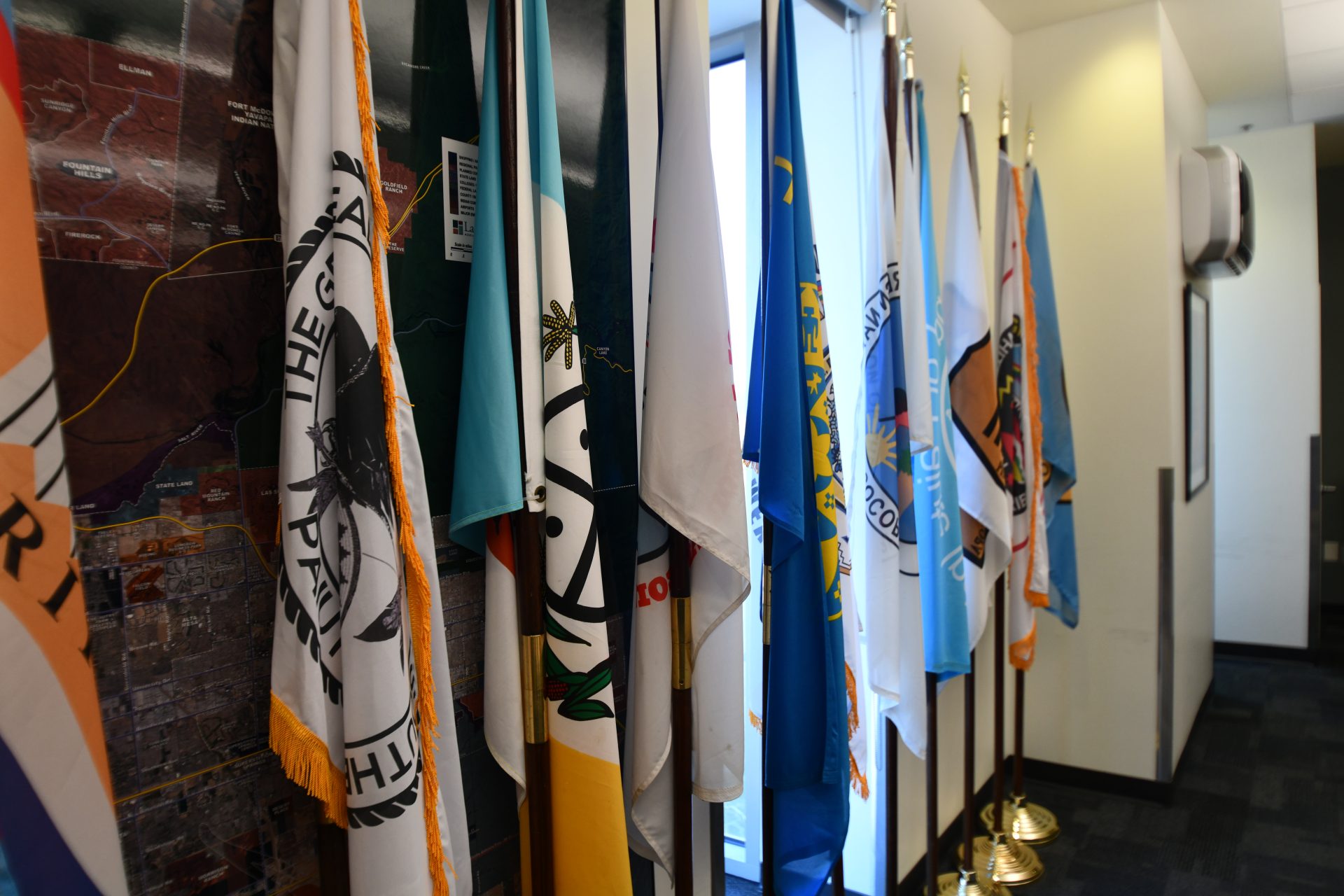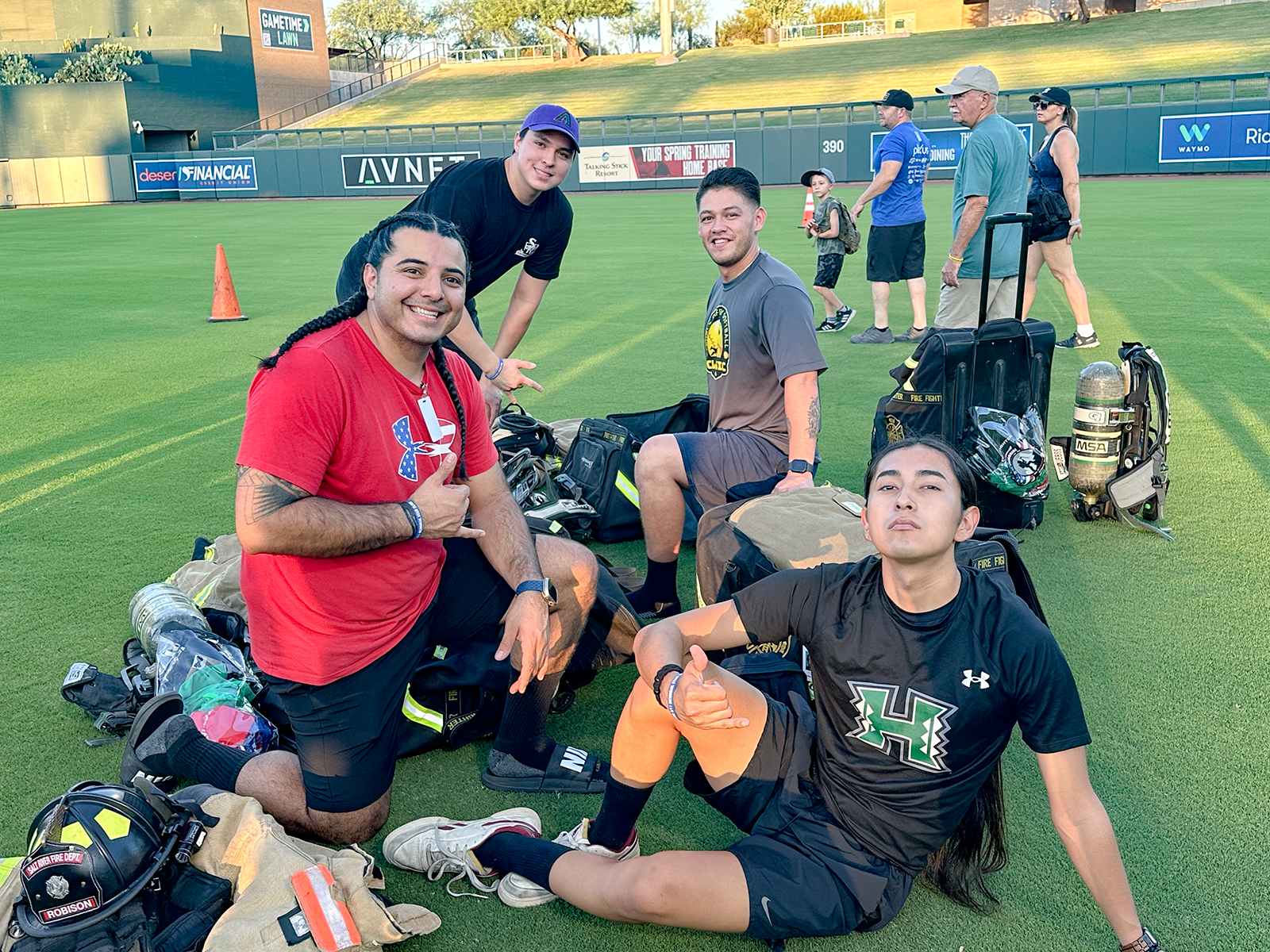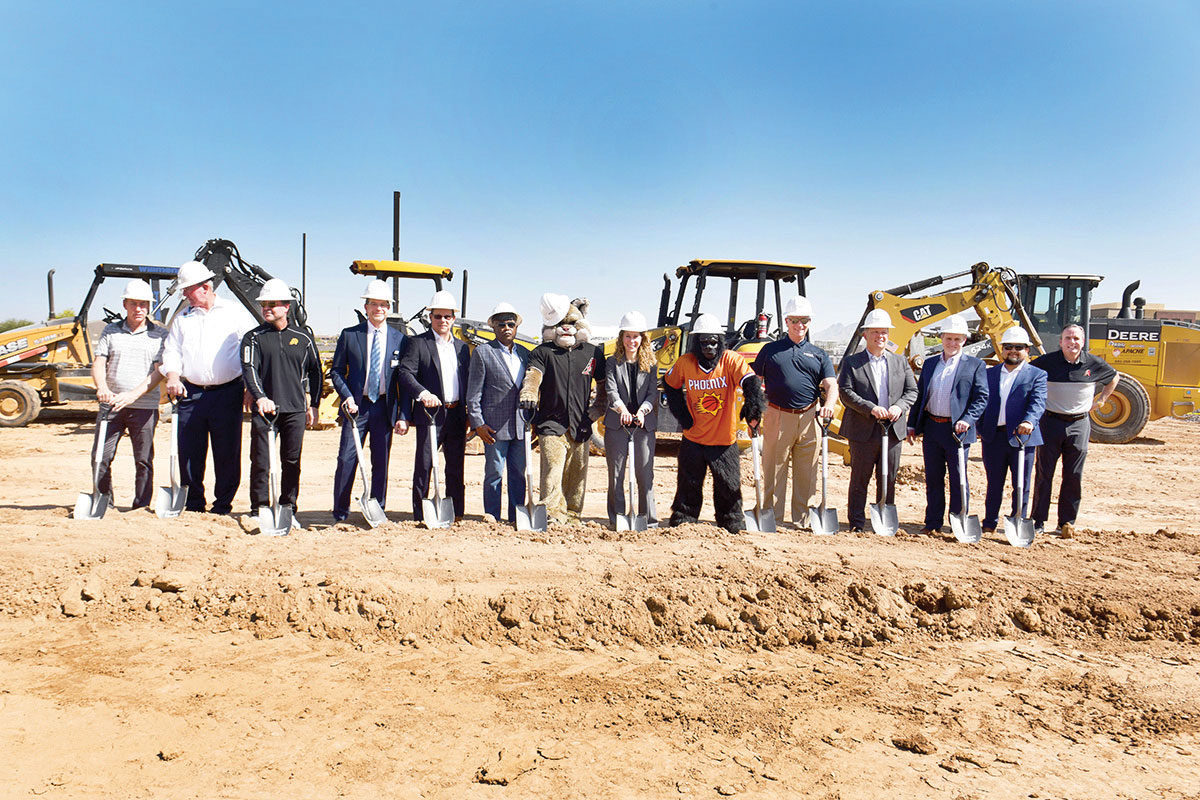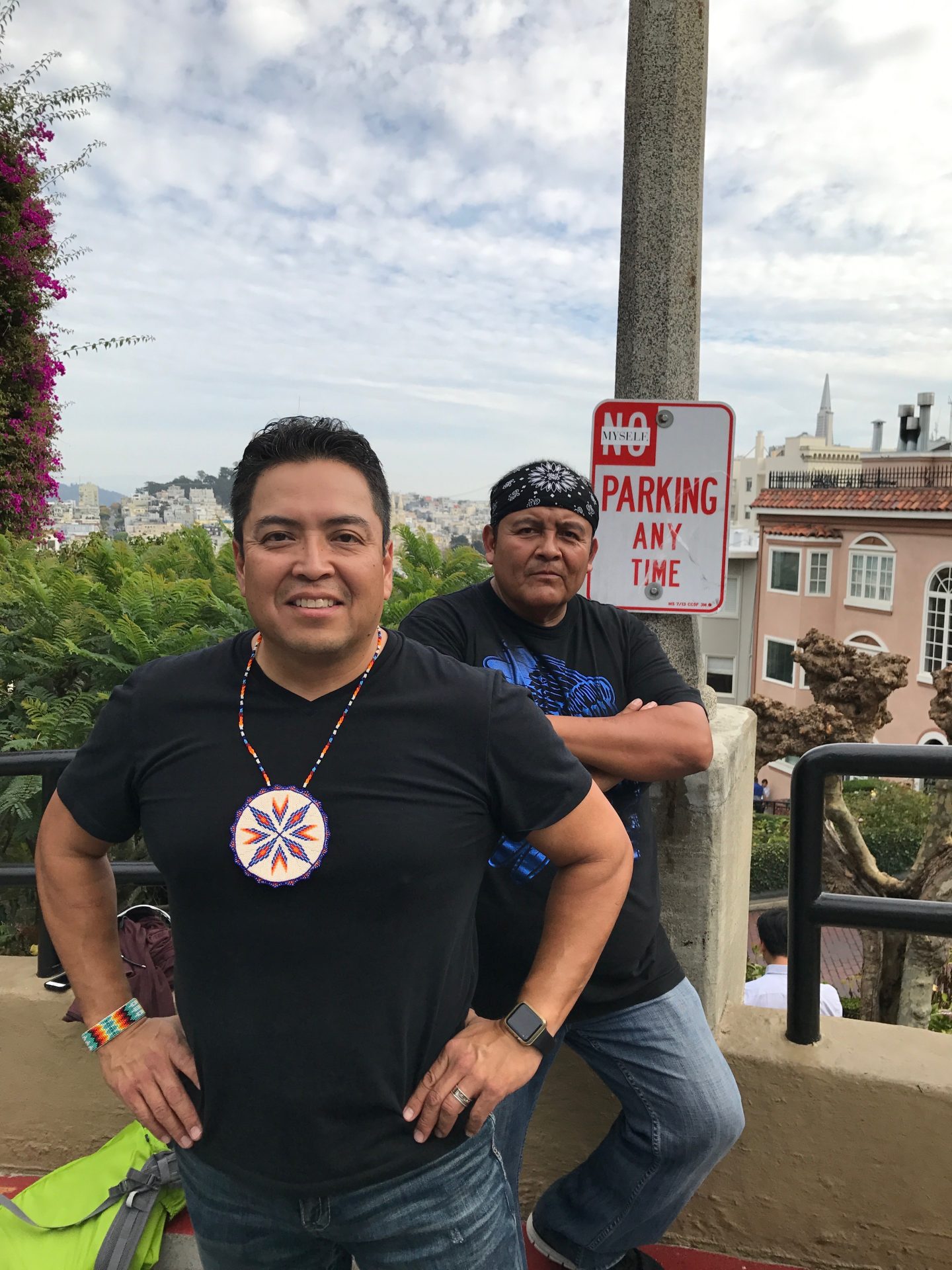VIEWS: 1227
April 7, 2025SRPMIC Becomes Temporary Sanctuary for Veterans Affairs Tribal Flags
**This article was originally an online exclusive published on March 20. It has since been updated.**
U.S. Army Veteran Michael Leon completed his duty on a recent March morning in the Salt River Pima-Maricopa Indian Community. The duty, unforeseen only months ago, overwhelmed Leon with emotion once it was completed.
Leon works for the Phoenix Veterans Affairs and was tasked to deliver 22 tribal flags from the VA to the SRPMIC on March 18. The alternative was placing the flags away in an anonymous warehouse somewhere in the Phoenix Valley for who knows how long.
“These flags, to keep them in a storage locked far away, that’s like putting chains on them,” he said, once the flags were carefully placed in their temporary new home in the Community.
The tribal flags represent the federally recognized tribes living in Arizona, including SRPMIC. The flags are over 20 years old and were a mainstay inside of the downtown Carl T. Hayden Veterans’ Administration Medical Center, not far from Steele Indian School Park. That changed in March following the executive orders implemented by the Trump administration in his first few weeks in office. This is when SRPMIC stepped in and stepped up.
“But then, we got in contact with Troy [Truax Jr.],” said Shawdin Tracy, Facility Rural Health coordinator for the U.S. Department of Veteran Affairs in Phoenix. After communicating with each other with not much time on their side, Tracy and Truax, who works for SRPMIC Veterans Services, created plans for the SRPMIC to become a temporary sanctuary for the flags.
During the early morning of March 18, all 22 flags were successfully transported from the VA facility to the third-floor conference room in SRPMIC Two Waters A-Building. President Martin Harvier, Vice-President Ricardo Leonard, SRPMIC Veterans Services Department staff, Community Manager Bryan Meyers and Rueben Malin, new director of Administration, were on-hand and assisted with the transport.
Once the flags were carefully moved to the third floor, Leon became emotional and shared a few words about the importance of continuing to show respect to the flags.
He shared his deep appreciation to the SRPMIC for agreeing to house and showcase the flags, just as they were inside of the VA office.
Following the transport, Leonard performed a feather blessing to all flags.
In a March 20 statement, Leonard called on the Veterans Affairs Secretary Doug Collins to restore the flag display at the Phoenix VA hospital.
The flags called SRPMIC home for about a week.
Once the news spread of the new location of the 22 tribal flags, Arizona tribal leaders released official statements that detailed their disappointments in the Trump administration for their decision to remove the flags from the Carl T. Hayden Veterans’ Administration Medical Center.
“As Chairwoman for the Cocopah Tribe, I find the removal of our tribal flags both insulting and disrespectful to all the members of the 22 federally recognized tribes in our state,” said Cocopah Tribe Chairwoman Sherry Cordova in a statement.
She continued, “The Cocopah Tribe is a small Tribe but per capita, we have had a large percentage of our men and women serve this nation only to be disrespected by the very country they defended.”
Arizona tribal leaders also provided their utmost appreciation to the SRPMIC for their swift action by housing the tribal flags temporarily in the Community.
On March 25, five days after the SRPMIC agreed to house the flags in the Community, Arizona Gov. Katie Hobbs made the decision to accept the 22 tribal flags to the Executive Tower Rotunda inside of her office in Phoenix.
“The Community is grateful that we had the opportunity to receive the tribal flags and to have them for the short time and we are thankful Governor Hobbs has agreed to take the flags to display them at the Arizona Capitol, a more prominent and appropriate place for them to be located,” said SRPMIC President Martin Harvier in a statement.
Gov. Hobbs reiterated that she would continue to honor and commemorate the sacrifices of tribal veterans.
“Arizona is proud of the Tribal Veterans who sacrificed for their country,” said Hobbs. “We should be recognizing their service, not disrespecting their heritage. It’s my honor to display these flags at the Executive Tower, and I am grateful to all the Tribal leaders who have entrusted me with this responsibility. I will always support our Veterans, and vow to keep these flags safe until they can be returned to their rightful place at the VA hospital.”
Erasing Native American Military Histories
The executive order to remove the 22 tribal flags from the Phoenix VA is another example of the Trump administration’s continued and ongoing efforts to erase certain history.
Since his inauguration in January, President Donald Trump has authorized several executive orders that saw the removal of Native American historical content from many federal websites, some temporary after blowback.
On March 12, the U.S. Department of Defense removed website content related to the Navajo Code Talkers, notable O’odham soldier Ira Hayes’ contribution at Iwo Jima during World War II and other Native military history. Across the country, calls for the content to be reinstated were introduced, resulting in the return of some of the Navajo Code Talker website pages days later, but not all.
White House officials informed the Navajo Nation that a process powered by artificial intelligence removed the websites as it was searching for content with diversity, equity, and inclusion (DEI) initiatives. This led to the deletion of any mentioning of websites or content related to “Navajo,” according to a statement from Navajo Nation President Buu Nygren.
The long and verifiable history of Indigenous people serving and protecting this country is not remotely affiliated with anything related to federal DEI initiatives. The contributions of Indigenous people protecting and serving America is undeniable. The removal of content from federal websites negatively impacts society as the Trump administration and their executive orders continue to threaten the military history and accomplishments of Indigenous peoples.
Interestingly enough, during his own proclamation on October 31, 2018, Trump acknowledged that Indigenous people have enlisted in the U.S. military at a rate of five times the national average. That proclamation has since been removed as well.
In a video posted to the SRPMIC online on March 19, President Harvier expressed his concerns regarding these changes. “These changes have brought so much uncertainty to our nation and raised questions as how tribal communities can work constructively with the federal government in the days, months and years to come.”
He added, “I want to assure you all that regardless of the circumstances, we will continue to provide the service that you expect and deserve.”
In the video, Harvier notified the Community that SRPMIC will be “taking the lead” by collaborating and working with the three sibling tribes (Ak-Chin Indian Community, Gila River Indian Community and Tohono O’odham Nation) and their elected tribal officials to “work on issues of common concern.”
Harvier reiterated that many current and former SRPMIC Council members serve on executive committees and boards that continue to ensure the safety and security of the Community and its membership.
As the video neared its end, Harvier encouraged the Community to attend upcoming Council meetings and to reach out by contacting Council if they have additional concerns or questions by dialing (480) 362-7469.
O’odham Action News will continue to monitor this story.







